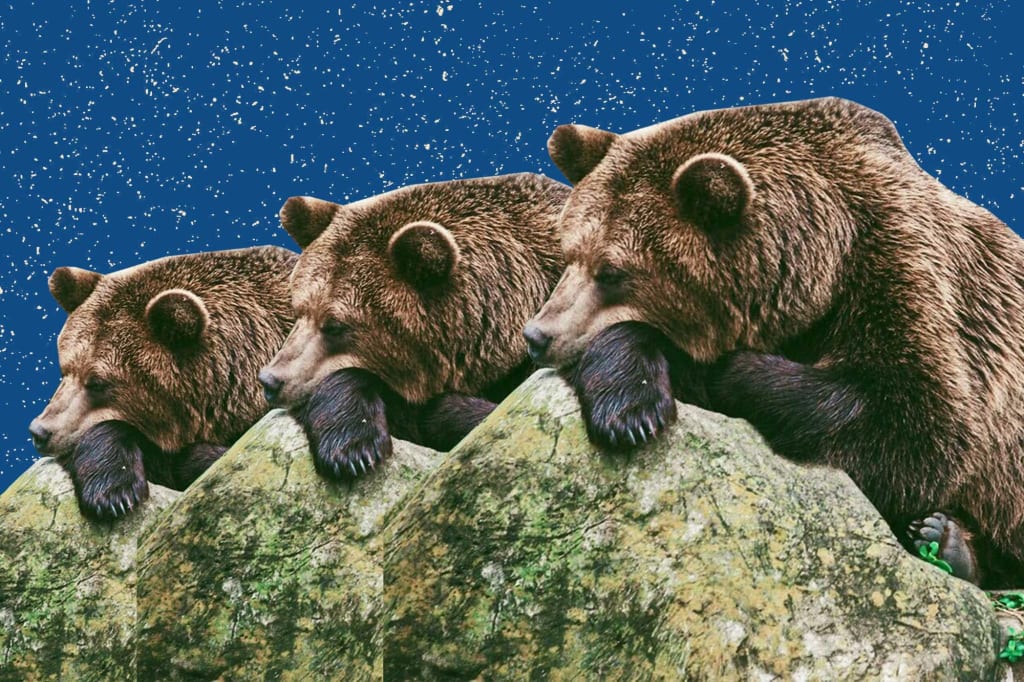
Bear Hibernation Unveiled: A Window into Nature's Marvel
The enigmatic world of bear hibernation beckons, inviting us to explore its intricacies and mysteries. Within this natural spectacle lies a story of profound adaptation and survival, painted in the delicate strokes of nature's artistry.
Imagine a bear, a symbol of strength and endurance, entering a state of dormancy as winter's icy grip tightens its hold. During hibernation, the bear's metabolic rate takes a dramatic plunge, diminishing to a mere 25% of its normal activity level. This radical slowdown is no accident; it's a survival strategy. The bear conserves its precious energy and resources, depending on the carefully stored fat reserves accumulated during the summer and fall.

But the bear's hibernation tale doesn't end there. One of nature's masterstrokes lies in its ability to lower its body temperature, seemingly in defiance of the winter chill. While the bear's core temperature remains relatively stable, it skillfully lowers the temperature of its extremities, such as its paws. This adjustment reduces heat loss and minimizes unnecessary energy consumption, demonstrating the remarkable adaptability that has allowed bears to thrive for millennia.
As if these feats weren't impressive enough, the bear further astonishes by reducing its heart and respiratory rates. This reduction contributes to an overall metabolic slowdown, enabling the bear to endure the extended winter months without sustenance.
During hibernation, the bear takes a vow of stillness. It abstains from eating, drinking, urinating, or defecating. Instead, it relies entirely on the stored fat, patiently waiting for the return of spring. The duration of hibernation varies depending on the bear species and local environmental conditions but can stretch on for several months, making it a true testament to the bear's remarkable adaptation.
Now, let's enter a different chapter of this story – the awakening of a hibernating bear. While the temptation to witness this incredible moment is strong, it's vital to prioritize the safety and wellbeing of both humans and the bear itself.
Awakening a hibernating bear is not just an interruption; it's a disturbance of nature's meticulous design. A premature awakening disrupts the bear's natural hibernation cycle, causing an abrupt spike in its metabolic rate, heart rate, and body temperature. This shock to the bear's system can result in stress, exhaustion, and even death. Furthermore, disturbing a hibernating bear deprives it of the critical energy reserves necessary for its winter survival.
But the risks extend beyond physiological disruptions. The bear, startled and possibly feeling threatened, may react aggressively. Bears are instinctively protective of their personal space. A hibernating bear, rudely awakened, may respond with growls, lunges, or, in the worst-case scenario, a deadly attack. These reactions are a manifestation of a bear's natural instincts, and the consequences can be catastrophic for both humans and bears.
Human-bear encounters, particularly in the context of hibernation disturbance, are not to be taken lightly. Bears are wild animals, and encountering a hibernating bear without the appropriate knowledge and experience can lead to unpredictable outcomes.

In regions where bears hibernate, it is imperative to adhere to guidelines and regulations established by local wildlife management agencies. Educating the public about bear behavior and the potential dangers of disturbing hibernating bears is essential to prevent hazardous situations. This knowledge empowers individuals to make informed decisions, maintain a safe distance from hibernating bears, and ensure their own safety and the bear's wellbeing.
In the event of an accidental disturbance to a hibernating bear, a calm and measured response is crucial. Slowly and quietly retreating from the bear without further agitation is the wisest course of action. Putting distance between you and the bear minimizes the risk of conflict. Additionally, carrying bear spray or other deterrents can be a valuable precautionary measure in such situations.
Conservation and coexistence are the cornerstones of our relationship with bears. Understanding the significance of hibernation is essential for the conservation of these incredible creatures and the peaceful coexistence of humans and bears.
Preserving bear habitats, ensuring a consistent food supply, and minimizing disturbances in these areas are critical steps in safeguarding bear populations. Conservation efforts encompass public education, habitat restoration, and rigorous enforcement of regulations to protect bears during their hibernation period.
Raising awareness of the importance of hibernation and the associated risks of disturbing bears fosters a deeper appreciation for these remarkable animals. It also encourages responsible interactions and a commitment to protect the wonders of the natural world.
In conclusion, the act of awakening a hibernating bear is an endeavor fraught with risks and should be avoided at all costs. The consequences, from physiological disruption to potential aggression, can have dire effects on both humans and bears. By emphasizing the understanding of hibernation, the respect of bears as wild animals, and the promotion of harmonious coexistence, we can ensure the safety and preservation of these incredible creatures while preserving the splendors of the natural world.





Comments (1)
Test is not accepting comments at the moment
Want to show your support? Send them a one-off tip.